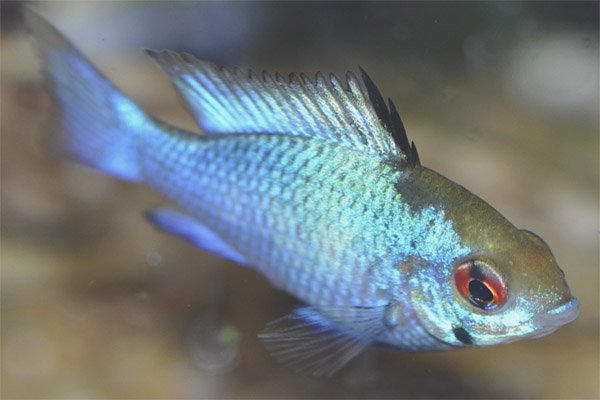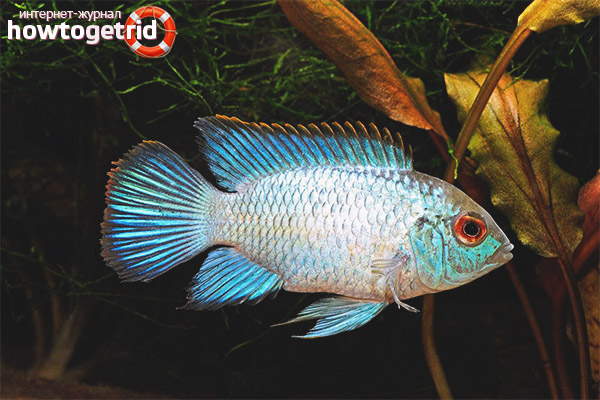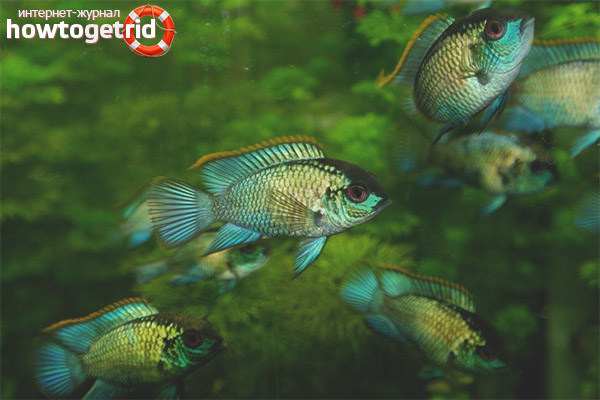The content of the article
All beloved cichlids cannot do without a neon electrician, who is otherwise called nannakara. Amateurs and professionals who are engaged in aquarism, be surely hooked into the water dwelling of these fish. They look favorably in the species aquarium, do not require special conditions in the content. Usually, mysterious blue cichlids are settled in pairs, they successfully exist and multiply. Today we look at everything that affects the presented species.
Origin
When data about these fish were only collected, it was widely believed that they met in 1954 in the Soviet Union. In fact, this information does not even share the truth. Representatives of the family lived in Asia.
In English-language Internet sources one can find references to the origin of nannakar. All the information leads to the fact that they were allegedly brought from Asia to Singapore, then representatives of cichlids began to fly around all countries of the world.
Most likely, the Asian origin and habitat is true.However, it is still unknown who became the progenitor of this breed. It is only known that electricians are descended from the blue spotted Akara, which participated in the creation of the species.
Description
- These fish love for external data, which are remembered and remain in memory forever. The advantages of neon include sparkling scales, thanks to which the fish is called flash, lightning. Nannakara is considered the most suitable option for keeping in large aquariums with a view.
- It shimmers with all shades of blue, turquoise, silver, greenish. The fish is not lost among other aquatic inhabitants. A uniformly colored body blends harmoniously with a gray-colored head.
- It cannot be said that the representatives of the family are small. They are in the middle or even a large range, depending on whom to compare. Nannakars reach about 15 cm in length; however, individuals of 10 cm are usually found.
- Sexual superiority is weakly expressed, so it is sometimes difficult to distinguish who is in front of you. But this applies only to beginners. Professionals know that females are smaller in size, slightly flattened and tall.The fish is strong and powerful, it can compete with large cichlids. Neons live only 5-7 years old if given everything they need in terms of maintenance and care.
- The fins in the anus and on the back are pointed in males. Female representatives are famous for rounded edges. The fins have a border of golden hue. The whole appearance suggests that the fish is harmonious and colorful, but not fanciful.
Content
- Inexperienced people who are just starting to keep fish, ask questions about whether it is difficult to care for this family. In fact, with proper theoretical preparation, there are no difficulties.
- Fishes are peace-loving, hardy, can tolerate temperature extremes, are famous for their strong immunity. Nannakars are good because they require less water area than other cichlids. But by nature, fish love to fight for territory, this must be taken into account.
- If you plan to keep two fish, then choose an aquarium, so that about 35–40 l will be needed for one individual. In cases where it is planned to contain a lot of fish, the calculation goes like this: one accounts for 30 liters.This applies only to the content of nannakar, excluding individuals of other species.
- Take care to properly lay the bottom of the aquarium. There are no special requirements for the ground, but we must proceed from the natural features of this family. It is better to choose small pebbles, quartz river sand, other variations up to 44 mm in size. Cichlids love the aquatic environment with a stiffness above the average, and from this it is necessary to proceed. Soil is chosen, for example, coral chips, which increases these indicators.
- The fish of this family do not have a predisposition to dig the soil and destroy the vegetation. Therefore, you can safely choose plants with any root system, without fear for the safety of the range. Nannakaras are shy, so the plantings should be moderately thick so that the fish can take shelter. They hide in the thickets of large roommates, if any. But it is not necessary to plant everything with plants, allocate a place for swimming.
- Important attention is paid to the aquarium interior. Again, according to temperament, neons are cowardly, which means they need a place to hide. You can put in a habitat pots of clay with slots, grottoes, plastic pipes and other accessories.Introduce flat stones into the interior, on which the fish will be able to spawn. Snags are selected at the discretion, but the best option would be mopane.
- It is important to ensure proper filtration of water, so purchase special equipment, taking into account the size of the vessel. Fish will be less sick if water is provided with oxygen. Once a week you need to drain ¼ section of the entire volume of fluid, then pour a new one. As for lighting, choose moderate diffuse lamps.
- You can not ignore the parameters of water, in which members of the family will feel comfortable. In order for fish to exist successfully, keep to a temperature range of 22–28 degrees, a hardness of 6–15 units, an alkaline balance of 6–8 pH.
Feeding
- Nannakara differs from most fish in that it is especially picky about food. Neon cichlid perfectly consumes live, dry and frozen food. Separately, it is worth mentioning that such individuals are particularly voracious.
- While feeding the fish, the cichlid will drive everyone away to get the most tidbits. Even among the relatives can be observed frequent skirmishes.Fish will not retreat until you eat enough.
- In priority, breeders recommend giving live food to individuals. They eat great cyclops, moths, koretra, artemia, mosquito larvae and daphnia. If you are going to feed fish with dry food, it is imperative that you additionally give spirulina.
- Also, fish are recommended to give scalded pieces of various vegetables. Such individuals prefer squash, cabbage leaves and cucumbers. As soon as the fish eat, they will still scour the bottom of the aquarium in search of food debris. Nannakars also eat all kinds of crustaceans.
Compatibility
- Do not forget that neon cichlids are predatory individuals, which are often kept in aquariums. It is worth noting that the nature of such individuals is formed directly due to the conditions of detention and residence.
- A huge role is played by the spaciousness and spaciousness of the aquarium. Also an important fact remains the temperament and size of other inhabitants of the environment. Any representatives of the aquarium need proper and proper care.
- Do not forget that during spawning cichlids become too aggressive.You should not be worried ahead of time. Such individuals will only repel other fish from their nests. And touch cichlids will be equally sized inhabitants.
- Neon nannakaras do not injure other fish during aggression. Therefore, to worry once again is not worth it. Such individuals perfectly coexist with barbs, scalars, pyrrulines, mollies, danios, petillas, tetras, terrationa, gouras, catfish and nanostomuses.
- If the aquarium is comfortable enough with many different shelters, all the inhabitants will live quite peacefully. Fish will not conflict with each other, if each has its own territory. It is worth knowing that it is better not to settle with small representatives of nannakars.
- Cichlids perceive any small animals as potential food. That is why they should not be hooked neons, guppies, shrimp, snails and rasborov. Otherwise, if you get larger individuals, the neon cichlid may be in the place of the victim.
Breeding
- Like all cichlids, neon also spawn. The entire breeding stage is similar to most fish.Such individuals can easily breed in the general aquarium. You do not need to make a special capacity for spawning.
- Representatives reach sexual maturity at about 7–12 months. At this time, neon cichlids find pairs for themselves. If the conditions in the aquarium are quite warm, then spawning will begin without any additional effort on your part.
- If you want to independently provoke the onset of throwing eggs, the water temperature must be increased by 2-3 degrees. Also, with independent spawning stimulation, it is necessary to replace water a couple of times a week. Do not forget to slightly raise the temperature of the habitat.
- As soon as the female begins to understand that the conditions for spawning become favorable, she selects a flat surface for throwing eggs. In this role can be a snag, a piece of clay or a stone.
- The female can chop from 50 to 300 eggs. After that, the male begins to fertilize them. Then the female provides the progeny with the necessary care. She is also trying with all her might to protect the future generation.
- After the first 3 days, the female moves the eggs to a hole dug in advance. After 5 days, the fry are born.At this time, the female furiously protects the offspring, even from the male.
Neon nannakaras are quite interesting representatives of the cichlid species. They are not as aggressive compared to their relatives. Providing the right conditions for keeping cichlids will not cause any problems with other inhabitants of the aquarium.
Video: Nannacar Neon Aquarium Fish













To send